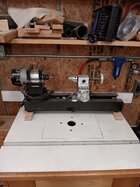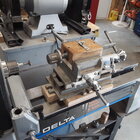A club member made a threading jig using a cross slide vise. It appears to work well. I am going to build one using his concept, however my lathe is a 25” swing where his is an 18” swing. So I need to make some modification. To account for the difference in swing I am going to mount the vise on a 4” wood base. Has anyone made a threading jig using a cross slide vise. I plan to use a cutter held by a collet. I would like to see pictures or any suggestions using a cross slide vise for cutting threads. I plan on two thread pitches, 8TPI and 10TPI. I could possibly do 16TPI, but guessing that would only work for the harder woods.
Yes, a Baxter would be nice, but$$$.
Yes, a Baxter would be nice, but$$$.










